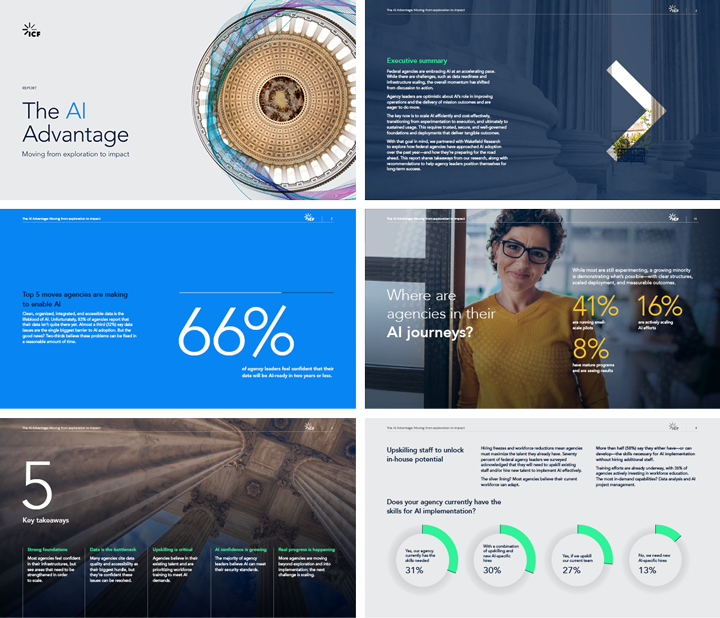
QuickSkills: Using GenAI to transform HR competency models
In human resource (HR) management, competency modeling is essential. From informing talent acquisition and employee development to underpinning performance management, competency models guide numerous HR initiatives.
Yet building these models is so time-consuming that HR leaders often rush development or skip regular updates. This rushed approach, while understandable given workload constraints, results in competency models that lack the precision and comprehensiveness required to effectively guide talent management efforts.
What if there was a better way?
Exploring the role of generative AI
At ICF, we continuously explore innovations in artificial intelligence (AI) to solve organizational challenges, automate workflows, and deliver better outcomes faster. We’re also focusing on generative AI, or GenAI, which is a subset of AI technologies capable of quickly creating high-quality, structured content based on clearly defined prompts.
According to our new report on AI-powered innovation, 40% of federal agencies are using AI to support project management and resource planning. The report also notes that all agencies are taking steps to expand their use of AI.
Our cross-functional team of experts at ICF set out to answer a critical question—can we use GenAI to build reliable, tailored competency models faster?
Integrating GenAI into traditional competency models
Competency modeling relies on various research methods and expert judgments that can be decomposed into three distinct stages (Figure 1). Organizations typically begin by developing an initial competency model based on available documentation. Then, they meet with SMEs to review the initial competency model and gather additional details. And finally, they collect data on the updated competency model to validate and finalize it.
Figure 1: 3 Stages of traditional competency modeling


Steps 1 and 3 require communication with stakeholders and SMEs—conversations, emails, conference calls, in-person meetings, and nuanced interpretations that depend on emotional intelligence and relationship management skills that are unique to humans.
By contrast, Step 2 involves identifying themes, abstracting and synthesizing concepts, and summarizing documentation, which are “cognitive” tasks that GenAI can perform quickly and effectively. Delegating Step 2 to GenAI may save time while still ensuring human oversight in Steps 1 and 3.
Using QuickSkills: An intelligent approach to competency modeling
We developed QuickSkills to assist in creating an initial competency model from existing documentation in Step 2. Using an intuitive, secure, and custom-built application, users submit their organization-specific documents—such as job descriptions, proprietary competency libraries, and vacancy announcements—into a protected, multi-factor authenticated environment restricted to internal access (Figure 2).
Figure 2: QuickSkills offers a custom-built search interface


QuickSkills uses advanced language models to swiftly synthesize and distill key themes, creating both base (generic) and tailored (job- and/or organization-specific) competency models. A few-shot learning approach, driven by strategically designed prompts and structured competency exemplars, guides the generation of competency names, definitions, and behaviors. QuickSkills can also generate detailed explanations of the differences between the base model and tailored model.
Better models, less time, and enhanced insights for federal agencies
QuickSkills delivers tangible, measurable, and sustainable value.
When developing a tailored competency model for a human capital expert, QuickSkills used public-sector job vacancy announcements, clearly showing how those supporting those agencies work directly with specific HR systems like DCPS, SLCADA, and TWMS. This level of detail ensures models are job-relevant and fosters more accurate recruitment and training outcomes. Figure 3 shows an enhancement to key behaviors for one competency.
Figure 3: Key behaviors for base and tailored competency models


QuickSkills dramatically accelerates competency model creation. Tasks traditionally requiring weeks of manual review, organization, and synthesis by multiple staff members can now be accomplished within minutes. The traditional approach might have required several weeks.
This substantial time savings frees HR staff to focus on more advanced research methods, as highlighted in Stage 3 of Figure 1.
Leveraging the unique strengths of humans and AI
Competency modeling still requires expert review and judgment to ensure the resulting model reflects real-world job requirements. However, strategically integrating GenAI into competency modeling using QuickSkills enables HR practitioners to optimize the strengths of both people and GenAI.
With QuickSkills, HR leaders no longer need to choose between thoroughness and speed. Instead, HR teams can drive meaningful workforce outcomes more quickly and thoroughly.
As HR leaders strive to accelerate workforce transformation and maintain peak organizational performance, QuickSkills offers a modern path forward. It gives HR teams better competency models that are built faster and smarter than traditional approaches.
Modern competency models drive workforce success
ICF supports the people, process, and program performance aspects of HR, human capital, and change management initiatives. Our competency modeling and underlying methodology play an effective role in human capital management systems by forming the foundation for talent acquisition, development, and performance management. We’ve conducted job analyses and developed competency models for more than 150 jobs.
We offer workforce planning and analytics to help federal agencies make informed decisions about the future of their workforce. Our solutions and expertise can help organizations achieve HR and workforce transformations. Find out more by contacting us.
